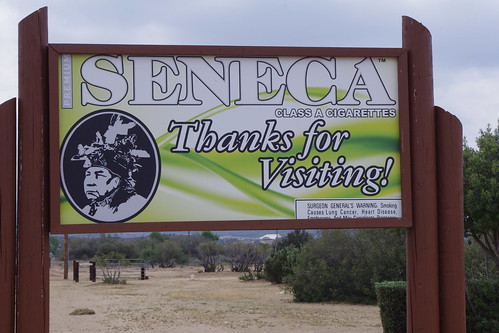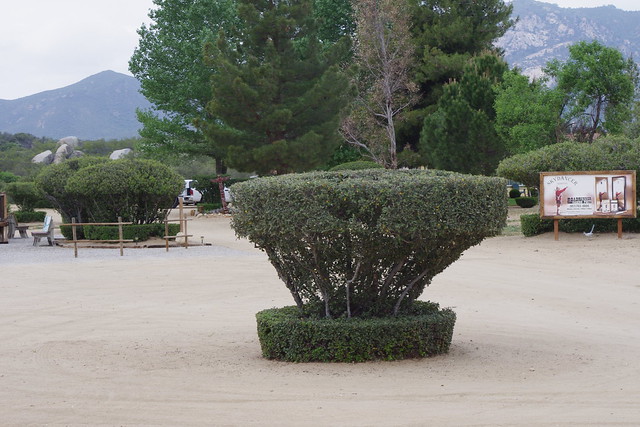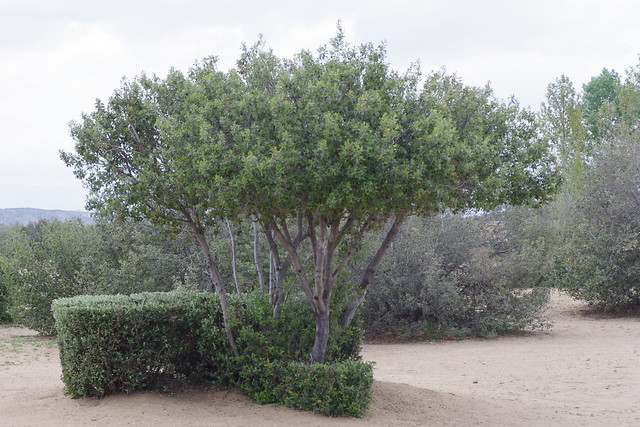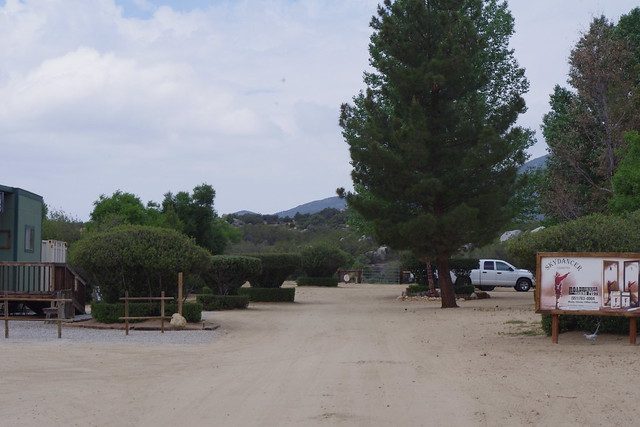 |
| Credit: Bencito the Traveler |
I never really enjoyed this ride at Disneyland. That theme song drove me nuts. But way back when it was the first time I had ever really been exposed to Animal Plant Sculpting of any kind. Of course various forms of hedges rows and barrier borders were always seen everywhere, but these types of creative plant sculptures were new.
 |
| Credit: Mine! SENECA Cigarette Shack on the Cahuilla Rez at Cary Rd, Anza, Ca |
Many of the bad examples frequently show up on Billy Goodnick's Crimes Against Horticulture: When Bad Taste Meets Power Tools website. But there are the conventional hedgerow borders that we are all familiar with and the well known conventional plants that have been used for years and available at most Retail Plant Nurseries like Boxwood, Privet and Yew to name a few. But for Southern Californians, there are some good Native Plant choices for which when established will NOT require the water of the non-native store bought varieties. Before I left for Sweden over 7 years ago, I drove down Cary Rd in Anza and past a property where someone was experimenting with all manner of plant sculpting by practicing on two natives, Mountain Mahogany and California Coffeeberry. I went back to photograph these last week, but didn't see the animal figures I had seen before or the Mountain mahogany shrubs, but did see the California Coffeeberry being used for various shapes and patterns in the wild landscape on Cahuilla Rez where of all things a Cigarette Shack resides. These Cigarette shacks were always common when traveling through Navajo Rez on Interstate 40 in northeastern Arizona, but former owner of Cahuilla Market, Chuch McKee, always said that they would end up on Cahuilla Rez in Anza one day and he was right.
 |
| Credit: Mine! Rhamnus californica 'San Bruno' This photo will be updated next week up in Anza |
The San Jacinto Mountains have a variety of native California Coffeeberry up there and in most cases I have always found them in the deeper sandy soils. Mostly on flood plains and alluvial fans, from Burnt Valley to Garner Valley. They are not necessarily the beautiful deeper shiny green of the various selected subspecies being sold at the native plant nurseries found around California. They have more of a dull olive green colouration about them. Many refer to them here as California Buckthorn. But they all have the same identical leaves, flowers and berries characteristics of all the other varieties of Rhamnus californica. So last Sunday I went with my brother and photographed these plants along Cary Road in Anza and below is a gallery of sorts of the sculpted Coffeeberry shrubs I saw. At the very least, it should get wheels turning as to how valuable and versatile those Natives can be used in the Southwestern Landscapes. I also went by my old place, but the new owners were not home. From what I could tell looking through the old stock gate entrance, the 25+ years old California Coffeeberry 'San Bruno' under the 25 year old Jeffrey Pine is still in great shape along with most everything else I planted years ago. I'll update these photos come next week if possible and write another post on the progress and update of the Table Mountain property.
 |
| Photo Credit: Mine! |
 |
| Photo Credit: Mine! |
 |
| Photo Credit: Mine! |
 |
| Photo Credit: Mine! |
 |
| Photo Credit: Mine! |
The other photos clearly illustrate the ability of this plant to form a dense healthy health for a nice sculpted wall or screen. But as with many chaparral species of plants, you can also trim them up to form a sun shade canopy for a private garden hideaway. Many Scrub Oaks, Sugarbush, Laurel Sumac and Lemonade Berry Chaparral Shrubs will serve this purpose nicely. Plus not only the water bill savings and the lack of pest infestations if properly taken care of and maintained, but also the attracting native wildlife will be another reason for utilizing what's been around for countless centuries for free. The most any of these shrubs will set you back is around $8 or $9 ea for a one gallon pot. Now take a close look at this photo below of a California Mule Deer eating Coffeeberry foliage.
 |
| Image: Town Mouse & Country Mouse Blog |
Next time you hear any of those "Just Add Water" justification stories for land clearing, forest thinning and/or control/prescribed burns because it provides foods for grazing wildlife, remember this deer and California Coffeeberry photograph. In all my hikes and journeying in the Southern California backcountry, I have more often than not found deer out browsing more than grazing. Yes, they are grazers, but also browsers. Many of their favourite game trail highways can be followed through dense chaparral. Watch out for Ticks though 😨
Great California Native Plant references and resources:
No comments:
Post a Comment
Thanks for visiting and for your comments!
I will try to respond to each comment within a few days, though sometimes I take longer if I'm too busy which appears to be increasing.